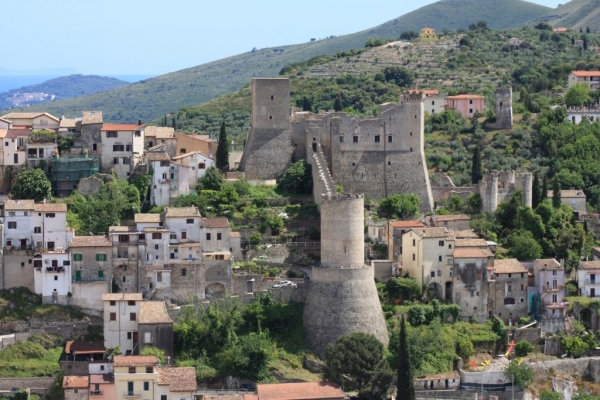The first plant was built around the 9th century at the behest of Docibile I, Duke of Gaeta and consisted of a single polygonal tower and a wall with towers. In the mid-10th century the original structure, an important outpost towards the hinterland of the Duchy of Gaeta, was enlarged at the behest of Marino I ° (grandson of Docibile I °) with the construction of a second square tower that exceeded the existing polygonal. Towards the middle of the 13th century the fief of Itri passed into the hands of the Caetani. The castle was enlarged with the construction of a two-storey residential area created by connecting the polygonal tower to the square one, a third tower, a patrol path and a parade ground. The third and last tower, cylindrical in shape and connected by the patrol walkway to the residential body and is known as the "crocodile tower", as according to a legend not confirmed by documents, the bottom of this tower was full of water and contained a ferocious alligator, to which prisoners undergoing a death sentence were thrown to meal. The area of the county, like many others along the Lazio coast, was the scene of raids by Arab pirates; precisely to escape a probable kidnapping by the Maghreb pirate Kedir El Din (The Barbarossa) Giulia Gonzaga found refuge in the fortress of Itri. Feudal countess of Fondi and widow of Vespasiano, Giulia Gonzaga as well as being a fascinating woman was one of the most illustrious women of the Renaissance, famous for the artists and writers who were part of her court.
In the seventeenth and eighteenth centuries the territories of the county of Fondi became part of the Kingdom of the Bourbons and due to its position, Itri found itself in the border area with the Papal State, sadly famous with the nickname of "no man's land" afflicted by Brigandage phenomenon. The fortress of Itri in those centuries was losing its defensive importance and was progressively abandoned; the brigand Marco Sciarra, who for some time had been at the head of a large number of brigands scattered throughout the border, took advantage of it by taking possession of it. The castle thus became his headquarters from which he could dominate a good part of the Via Appia frequently traveled by unfortunate travelers who were extorted by Sciarra and his brigands. According to a legend, the figure of Michele Pezza, a famous brigand born in Itri in 1771 and known as Fra 'Diavolo, also had to do with the fortress of Itri; it is said that against the French troops of General Jean Etienne Championnet, he used some underground tunnels of the castle to escape out of the city and make fun of both the general and the French army several times.
In more recent times, during the last World War, the fortress of Itri once again found itself in the center of a strategic area where fierce fighting was held: the Gustav Line. Damaged together with the city by heavy American bombing, the castle reported extensive damage to the roofs of the residential building, a part of the polygonal tower was gutted and a large part of the crenellated walls that covered the various structures was lost.
After years of neglect, the structure was purchased in 1979 by the Province of Latina to be later donated to the municipality of Itri and restored. The inauguration of the first restored part took place in 2003, however only in 2007 the entire structure was opened. The Castle of Itri can now be visited for a fee and hosts exhibitions, local craft markets, conferences and various ceremonies.
You enter the castle passing through the parade ground, surrounded by a wall and small towers. Going up a staircase you arrive at a reception where you pay the ticket (5 Euros) and a kind guide begins to explain the history of the castle. The visit begins from the rooms to the left (corresponding to the first floor of the residential area) three large and austere halls; from the second one you can go down to the lower floor, consisting of as many rooms most likely intended for domestic use in the past, as is supposed from the remains of an oven and a tank used to store food; moreover it is possible to observe the ancient cistern where the rainwater was collected. On the second floor you can see the remains of a fireplace and those of a fresco depicting Saint Anthony the Abbot and a Madonna with Child in the spot where the private chapel of the Caetani was located. Going up the last staircase, it is possible to exit and access the large panoramic terrace, from which one dominates the route of the Via Appia near the city and the view sweeps from the Aurunci mountains towards the north until you see Gaeta and the sea towards the south. admired the fascinating panorama, walk along the characteristic walkway that connects the residential building to go towards the legendary circular tower; via a wide spiral staircase is







